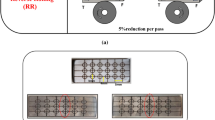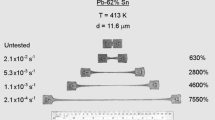A working hypothesis is proposed for the mechanism of the effect of deformation regimes on granular structure and phase fineness governing an increase in ductility for silumins and low-alloy steels. In particular, an alternating nature of deformation during helical rolling (HR) provides a reduction in grain size by a factor of 5–6 compared with longitudinal rolling. For hypereutectic silumins with HR it is possible to obtain a polygonized subgranular structure, to increase α-solid solution grain and silicon crystal fineness, giving them a globular shape, and thereby provide a capacity for treatment under pressure. An important role in increasing deformation capacity of silumins is played by the new technology of melt modifying treatment and optimum temperature-rate deformation regimes.









Similar content being viewed by others
References
E. I. Panov, Plastic Deformation of Cast Hypereutectic Silumin Alloys with a High Silicon Content [in Russian], Metallurgizdat, Moscow (2012).
E. I. Panov, “Main factors affecting the mechanism of structure formation and increasing hypereutectic silumin ductility properties with three-roll helical rolling,” Metallurg, No. 4, 69–75 (2006).
A. A. Bogatov, Metal Mechanical Properties and Failure Models [in Russian], UGTU-UPI, Ekaterinburg (2002).
D. V. Ovchinnikov, A. A. Bogatov, and M. V. Erpalov, “Development and introduction of manufacturing technology for compressor pump pipes from a continuously-cast billet,” Chern. Met., March, 18–21 (2012).
A. I. Tselikov, V. M. Lugovskii, and E. M. Tret’yakov, Vestn. Mashinostr., No. 7, 49 (1961).
V. C. Smirnov, Transverse Rolling [in Russian], Mashgiz, Moscow (1949).
A. D. Tomlenov, Metal Forming Mechanics [in Russian], Mashgiz, Moscow (1963).
V. A. Kolmogorov, Stresses, Strains, Failure [in Russian], Metallurgiya, Moscow (1970).
B. A. Romantsev and A. V. Lisovskii, “Study of the possibility of thermoplastic processing of high-strength cast irons,” Continuous Forming: Proc. All-Russ. Sci.-Tech. Conf. Devoted to the 100th Anniversary of Academician A. I. Tselikov, Moscow (2004), pp. 38–42.
Author information
Authors and Affiliations
Corresponding author
Additional information
Translated from Metallurg, No. 5, pp. 75–81, May, 2013.
Rights and permissions
About this article
Cite this article
Bogatov, A.A., Panov, E.I. Effect of Stress-strain State during Helical Rolling on Metal and Alloy Structure and Ductility. Metallurgist 57, 434–441 (2013). https://doi.org/10.1007/s11015-013-9751-8
Received:
Published:
Issue Date:
DOI: https://doi.org/10.1007/s11015-013-9751-8




